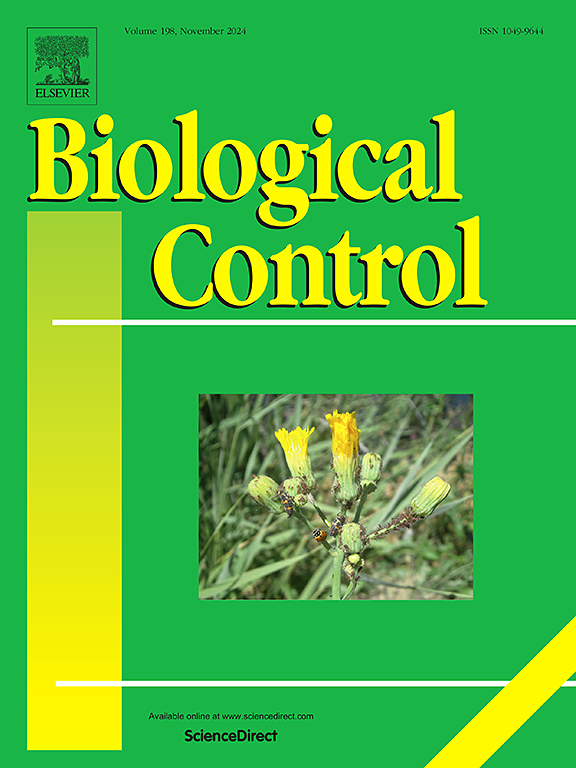The role of parasitic Hymenoptera in biological control of forest insect pests in South Korea: A review of invasive and native species management
IF 3.4
2区 农林科学
Q2 BIOTECHNOLOGY & APPLIED MICROBIOLOGY
引用次数: 0
Abstract
Forests are vital ecosystems that provide considerable environmental, social, and economic benefits. However, they are increasingly threatened by both invasive and native insect pests. This review examines the role of parasitic Hymenoptera species in managing key forest pests in South Korea, including invasive species such as Metcalfa pruinosa (Say) (Hemiptera: Flatidae), Lycorma delicatula (White) (Hemiptera: Fulgoridae), Hyphantria cunea (Drury) (Lepidoptera: Erebidae), and Thecodiplosis japonensis Uchida and Inouye (Diptera, Cecidomyiidae), as well as native pests like Monochamus alternatus Hope, M. saltuarius (Gebler) (Coleoptera: Cerambycidae), and Lymantria dispar asiatica (Butler) (Lepidoptera: Erebidae). Biological control strategies, particularly those utilizing natural enemies such as parasitoid species, have become increasingly prominent and environmentally sustainable alternatives to chemical methods. This review highlights recent advances in the mass rearing of parasitoids such as Sclerodermus harmandi Buysson (Hymenoptera: Bethylidae) and Neodryinus typhlocybae (Ashmead) (Hymenoptera: Dryinidae) and their effectiveness in reducing pest populations. Furthermore, this study provides a comprehensive review of the ecological and biological characteristics of these biological control agents, including their parasitism rates and roles in integrated pest management, to assess and introduce the current state of research on the natural enemies of key forest insect pests in South Korea. By synthesizing recent research, this paper underscores the importance of Hymenoptera-based biological control as a sustainable approach for promoting forest health and biodiversity conservation in South Korea.

寄生膜翅目昆虫在韩国森林害虫生物防治中的作用:入侵和本地物种管理综述
森林是重要的生态系统,提供可观的环境、社会和经济效益。然而,它们正日益受到外来和本地害虫的威胁。本文综述了寄生性膜翅目昆虫在防治韩国主要森林害虫中的作用,包括入侵种如金翅目蚁(半翅目:扁蝇科)、白蛉目Lycorma delicatula(半翅目:白蛉科)、美洲盲蝽(白蛉目:白蛉科)、日本盲蝽(双翅目:白蛉科)、日本盲蝽内田和Inouye(双翅目:白蛉科),以及本土害虫如黄翅目单翅目、白蛉目(白蛉目:白蛉科)等。天牛科)和亚洲野曲蝇(布氏)(鳞翅目:野曲蝇科)。生物防治战略,特别是利用拟寄生虫等天敌的防治战略,已日益突出,成为化学方法的环境可持续替代品。本文综述了近年来国内外对哈曼硬皮蝇(膜翅目:干蝇科)和斑蚜小蜂(膜翅目:干蝇科)等寄生蜂的大规模饲养及其在减少害虫数量方面的研究进展。此外,本研究还全面综述了这些生物防治剂的生态学和生物学特性,包括它们的寄生率和在害虫综合治理中的作用,以评估和介绍韩国主要森林害虫天敌的研究现状。通过综合最近的研究,本文强调了膜翅目生物防治作为促进韩国森林健康和生物多样性保护的可持续方法的重要性。
本文章由计算机程序翻译,如有差异,请以英文原文为准。
求助全文
约1分钟内获得全文
求助全文
来源期刊

Biological Control
生物-昆虫学
CiteScore
7.40
自引率
7.10%
发文量
220
审稿时长
63 days
期刊介绍:
Biological control is an environmentally sound and effective means of reducing or mitigating pests and pest effects through the use of natural enemies. The aim of Biological Control is to promote this science and technology through publication of original research articles and reviews of research and theory. The journal devotes a section to reports on biotechnologies dealing with the elucidation and use of genes or gene products for the enhancement of biological control agents.
The journal encompasses biological control of viral, microbial, nematode, insect, mite, weed, and vertebrate pests in agriculture, aquatic, forest, natural resource, stored product, and urban environments. Biological control of arthropod pests of human and domestic animals is also included. Ecological, molecular, and biotechnological approaches to the understanding of biological control are welcome.
 求助内容:
求助内容: 应助结果提醒方式:
应助结果提醒方式:


